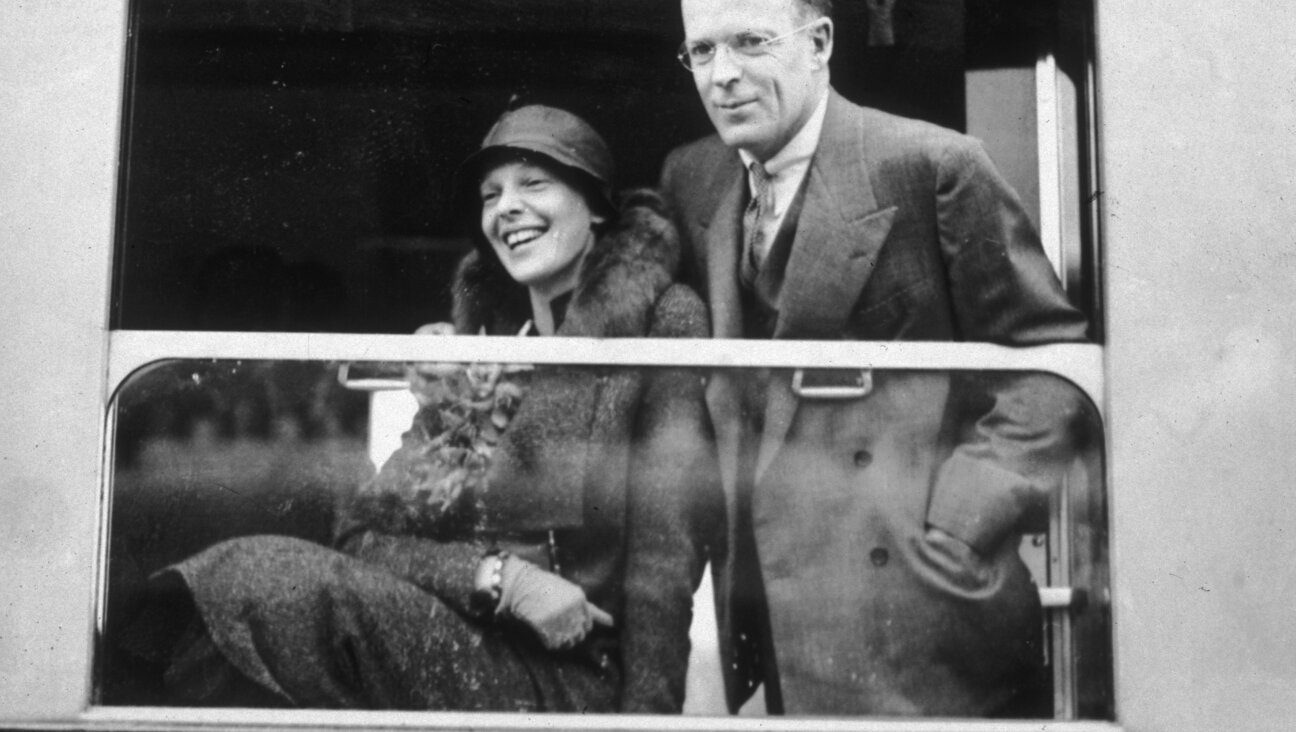‘A lot of Black artists feel that burden — the atypical ascent of choreographer Claudia Schreier’

Graphic by Angelie Zaslavsky
In the late afternoon and evening light of August, two solo hikers meet by a yellow steel structure in a grassy field. Their faces are obscured behind masks etched with anxiety as they navigate a world inhospitable to Black bodies like theirs. When they happen upon each other, their masks come off as they find familiarity and perhaps a moment of comfort — but only briefly before they go their separate ways.
The yellow structure is an installation by the artist Rashid Johnson, standing 16 feet tall beneath the open sky at Storm King Art Center’s vast outdoor museum in New York’s Hudson Valley. The masks are literal, also Johnson’s creation. The dancers wearing them are the titular figures in “The Hikers,” a ballet he and choreographer Claudia Schreier first conceived of as a film and later adapted for live performances in gallery spaces in Aspen, Mexico City and New York City — and, later this month, outdoors at Storm King.
“The Black body is often idolized to a fault and represented as this absolute form of strength and beauty and power, which strips the Black identity of a lot of its personhood, a lot of its vulnerability, a lot of its humanity,” Schreier said. “And so ‘The Hikers’ is, in part, about showing or exploring what it means to be Black and what it means to be human.” It is “about upending stereotypes about Black bodies moving through space, and also depicting the discomfort inherent in being a Black body moving through white space.”
“The Hikers,” which premiered in its first iteration in the summer of 2019, isn’t typical of Schreier’s ballet repertoire — up until that year, she hadn’t created anything like it.
‘Music and Dance Were a Part of My Existence’

Artist in Training: Claudia Schreier’s first choreographic work. Courtesy of Claudia Schreier
Born to a Jamaican mother and a white father of Eastern European Jewish descent, Schreier grew up in New York City — where she saw American Ballet Theatre’s “The Sleeping Beauty” as a toddler and soon started creative movement classes at the Y — and then the predominantly white suburbs of Westchester. “I grew up in a home infused with music,” Schreier said. “My dad loves classical music. My mom loves classical music. I grew up with a lot of calypso and reggae around the house as well. So just from an early age, music and dance were just a part of my existence.”
But Schreier didn’t take the usual path, if there is one, into ballet choreography. Often, a choreographer will emerge from within the ranks of a ballet company, creating new works for colleagues or affiliated students while still performing themselves. Though she trained seriously growing up, Schreier never became a professional dancer herself. “I was such a bunhead and I was so in love with ballet,” she said. “When it became clear to me that ballet was not going to happen, I begrudgingly applied to way more schools than I should have.” She headed to Harvard — a dream school though she wouldn’t have admitted it out loud — where she majored in sociology and minored in dramatic arts.
“There really wasn’t any immediate indication to me that ballet would be a large part of my life going forward,” she said. “And it certainly didn’t seem to be the case that it would be something that I’d make a career out of in any capacity.” But when she arrived on campus, she immersed herself in the dance community. In that setting, away from the professional dance world, “you’re there because you love the art, you’re there because dance is such a part of your identity, and you want to continue to foster that no matter what happens on the other end.”

Where It All Began: Claudia Schreier’s first performance. Courtesy of Claudia Schreier
She found like-minded students — some of them former professionals and others dancing at high levels — willing to rehearse until midnight on top of their demanding course loads. The “fertile and supportive environment” allowed her to be “making for the sake of making,” without the pressures of churning out premieres on deadline or facing reviewers on Day One. By the time she was a senior, she knew she wanted to keep at it, “but I couldn’t figure out what that meant or how it was supposed to happen.”
Two consecutive summer internships at Vail Dance Festival in 2007 and 2008 — before and after her final year at Harvard — led to a job at Chamber Dance Project and marketing roles at Alvin Ailey American Dance Theater, where she worked in the office for seven years while spending her free hours in the studio creating ballets. In 2017, nearly a decade after graduation, she was finally able to call the latter her full-time job.
Schreier has made a name for herself with abstract works and impeccable musicality, choreographing for her own Claudia Schreier & Company as well as organizations including Vail Dance Festival, American Ballet Theatre Studio Company, Miami City Ballet, Atlanta Ballet — where she was named resident choreographer last spring — and Dance Theatre of Harlem.
“A Haven for Dancers of All Colors”

Passage: A ballet choreographed for Dance Theatre of Harlem, by Claudia Schreier. Courtesy of Claudia Schreier
Virginia Johnson, a founding member and former star of Dance Theatre of Harlem (DTH) and now the company’s artistic director, encountered Schreier’s work at a showing at the Ailey studios, back when Schreier’s day job was upstairs in the marketing offices. “I was always on the lookout for people who had skill, who had talent, who had passion,” said Johnson (no relation to Rashid Johnson). And this, she remembered, “was really very wonderfully crafted work and very clearly and deeply thought-out work.”
Schreier became someone to follow. “One of the things that is important to me, because DTH is of course a ballet company, is somebody who has ballet as their first language, that understands how to use the very particular structure and aesthetic and ideals that are encapsulated in ballet as part of their contemporary voice,” Johnson said. “You can applique classical ballet onto something, or it can be part of who you are. And I really felt that that was what Claudia had,” she said. “And then of course, I’m also looking for people of color who have ballet as their first language to bring a different perspective on what can be said in ballet to the stage.”
The right opportunity came with a commission for the Virginia Arts Festival as part of a 1619 commemoration that marked 400 years since enslaved Africans arrived at Point Comfort, Virginia, on the shores of what was then a British colony. The idea was not to make a narrative depiction of slavery, but to acknowledge, honor and reflect on the past. Still, it was incredibly daunting. Schreier was working for the first time with a venerated company founded as a “haven for dancers of all colors” by Arthur Mitchell, who’d made history as the first African-American principal dancer at New York City Ballet. So she was trying to honor Mitchell and his legacy shortly after his death and, on top of that, to speak to this formative moment in American history in a way that felt true to herself and her artistic voice.
Working with the composer Jessie Montgomery, who was simultaneously creating an original score for the piece as Schreier planned the ballet, she wanted to keep it abstract. “We were fine with having some sort of abstract thematic through-line, but we didn’t want to have any explicit depictions.” Ultimately, they hoped the piece would speak to “the endurance of the human spirit and the willingness to prevail,” Schreier said, while portraying the “survival and cyclical struggle of people, of our people.”
“Passage” premiered in early May 2019 in Norfolk and was presented at The Kennedy Center in Washington, D.C. later that month. “In the pain and in the suffering of this history, the beauty that she managed to carve through the work,” struck Endalyn Taylor, a former member of Dance Theatre of Harlem and an advocate for dancers of color in ballet who has just taken the helm as the new dean of the School of Dance at the University of North Carolina School of the Arts. “Also a sense of resilience and perseverance — which I think really epitomizes many of the ways Black people and people of color have survived and overcome the challenges that they have had to as part of a system of racism, systemic racism,” said Taylor, who admired Schreier’s ability to evoke emotion without being literal. “It’s such a fine line to be able to draw people into your work without slapping them over the face with the ideas that you want to convey. And I think she strikes that balance brilliantly.”
‘A New Pathway’

Passage to Excellence: Claudia Schreier rehearses with the Dance Theatre of Harlem. By Rachel Neville
That commission “was the first time that I had really challenged myself to speak to Blackness through dance in an explicit way,” Schreier said. While she’d always recruited dancers of color and Black dancers specifically to perform her works, she hadn’t centered Black experiences or histories as themes of her creations. In part, it was a process of becoming more comfortable with herself. She grew up in a mostly white, privileged community where very few people looked like her and absorbed the kind of “underlying latent racism” that can fester unrecognized for years. “It took me a while to come to terms with how I saw myself, how I identify with my own Blackness, and how I placed that within the world of ballet,” she said.
The opportunity with DTH “created a new pathway for me,” she explained. “I am indebted to that commission for helping me find a more powerful voice.”
Schreier was working on “Passage” at the same time as she was collaborating on “The Hikers” project. The overlap allowed her to draw on very different movement styles and approaches, she said. “It was liberating because I could go between these two spaces and create work on Black dancers that spoke to different facets of the Black experience, without having to feel pigeonholed into either because I was at once allowing myself to see, well, OK, in this space, what does this represent? In this space, what does it mean to be Black? And for me, that was very freeing and it was also illuminating.”
‘This Is Something That You Carry With You Until It Just Becomes Too Much’.

Hikers: A performance conceived by Claudia Schreier and Rashid Johnson first as a film and later adapted for live performances in gallery spaces in Aspen, Mexico City and New York City. By Van Wampler
By the time Schreier was imagining the next project that would allow her to continue exploring some of these same questions, a global pandemic had shut down studios and theaters, George Floyd had been murdered like so many other Black Americans, and anger and anguish over the endless stories of brutality had boiled over into the streets of cities and towns across the country.
“A lot of feelings flooded through and up and everywhere very quickly” last year, said Schreier, who was slated to participate in the Guggenheim Museum’s virtual commissions program. Put in place almost immediately in the wake of coronavirus shutdowns to support artists looking to create even as traditional venues went dark, it asked participants to make videos under five minutes long that could be posted online.
She knew she wanted to speak to that surge of emotions she was contending with, but “artistically and personally and emotionally, I needed to take some time to absorb what was going on and reflect on it,” she said. Earlier this year, while living temporarily in Chattanooga, Schreier began talking with her husband and partner on the project, filmmaker Adam Barish, about what the film could be and speaking and rehearsing virtually with Keith Reeves, the Atlanta Ballet company member who would star in it, before heading to Atlanta to film.
“We had a lot of conversations about Blackness and about walking through the world while Black and all the things that could mean and how that could be represented,” Schreier said. “This work was dedicated to Black people for whom daily existence is survival.”
The video begins with an alarm clock beeping followed by the first notes of Duke Ellington’s “The Single Petal of a Rose.” A man’s head and his bare shoulders appear in the frame as he sits up, pauses and stretches, then builds up to calisthenics. In quick succession, he dons the layers he needs to face the outside world: socks, undershirt, button-down, belt, shoes, jacket. Poised to exit, he hovers for a moment at the door, then continues. As he makes his way down the streets of Atlanta, the man is hyper-aware of everything and everyone around him, veering out of the way, stepping off the sidewalk, reaching his hand out to pet a dog only to have it yanked away by its owner.
“There are these little micro moments that to anyone unassuming or to anyone who walks through the world and doesn’t have to worry about the way they carry themselves or the way that they present in the world can seem so minor and negligible and just forgettable, honestly,” Schreier said. “But to someone like this character, like this person, it just builds and it builds and it builds, and this is something that you carry with you until it just becomes too much,” she said. “The quotidian element of it was something we really wanted to emphasize — that this is not just a day in the life of this man, this is every day in the life of this man.”
At one point, the man closes his eyes and when he opens them again, he finds himself alone in a field. The camera has zoomed out, the light is soft as the sun sinks, invisible below the horizon, and he begins to move expansively. “It’s a moment of freedom. It’s a moment to find himself uninhibited by the weight of the world,” Schreier said. “It’s the moment in the day where he can take that deep breath, find himself and then carry forward. But nothing has changed.” Transported back to the city streets once again, he allows himself to move as he did in the field for a few seconds before catching and collecting himself and facing reality once again.
The film felt very personal for Reeves. “It really did resonate with me, especially being Black and just my experience going through the dance world and navigating everyday life,” he said. More broadly, “I feel like it was much needed,” said Reeves, who’d stayed out protesting with his roommates for a week or two straight last spring. “It was great for the African-American community to see a film that’s ballet-based tell a story about someone that is a reflection of them..”
‘If You Have Only One Point of View, Ballet Can’t Change’

In the Studio: Claudia Schreier with Dandara Veiga and Chris Bloom. By Dmitry Beryozkin
Ballet is, historically, a white, Eurocentric art form that has elevated the voices of men as creators and leaders even as the art form is often associated first and foremost among the general public with women as practitioners: images of women in tutus being escorted around the stage by their male cavaliers — or the more modern incarnation of women in leotards being manipulated to extremes by their male partners. Only about a quarter of the works programmed by the top 50 ballet companies in the U.S. for their 2019-20 seasons were choreographed by women, according to the Dance Data Project, up from 17 percent the previous year.
When it comes to race, ballet in America is still counting firsts. Perhaps the most famous outside of ballet circles, Misty Copeland became the first Black woman to be named a principal dancer at American Ballet Theatre in 2015. New York City Ballet had its first Black Marie, the child at the center of its famous production of “George Balanchine’s The Nutcracker,” in 2019 — 65 years after the ballet’s 1954 premiere. And in 2020, Sidra Bell became the first Black woman ever to choreograph a work for NYCB during its digital fall season.

Pleiades Dances: Jordan Leeper, Jackie Nash and Anderson Souza in a ballet choreographed by Claudia Schreier. By Brian Wallenberg
So Schreier’s path to a career in ballet choreography isn’t just atypical in that she attended a prestigious university rather than dancing in an elite company. It’s also still rare for Black women to be onstage with those ballet companies, let alone to make the works presented. “For such a long time this art form has been the voice of the dominant society, very often the male voice,” said DTH’s Johnson. “As long as you only have one point of view, one vision of what can be said or what needs to be said, then ballet can’t change,” she added. “It is absolutely essential that ballet begin to tell more and different stories and that it has more and different creators.”
Taylor, too, insists that ballet must open itself up to a more diverse mix of performers, choreographers and stories. “It is a form and a discipline and a genre that has a lot of space for those narratives to live and be highlighted and celebrated,” she said. At the same time, what artists “should have is this endless wellspring of abilities and opportunities to create anything we can imagine and not feel a sense of responsibility to stay in a certain lane,” she explained. Schreier “should be allowed to be a choreographer who happens to be a woman of color. So the range of what she is capable of doing should not be boxed or limited [and] I look forward to seeing the many avenues and directions and stories that she seeks to convey through her work.”
In the two years that Schreier made “Passage,” “The Hikers,” and “Force of Habit,” she also made works that took her in entirely other directions. “Pleiades Dances,” set to music by Japanese composer Takashi Yoshimatsu, for example, was “pretty much as abstract as it gets,” said Schreier. Working on it with Atlanta Ballet in early 2021 alongside “Force of Habit” provided a necessary counter. “I needed to create something that challenged me in a different way and represented who I am from that perspective. I needed that just as much as I needed ‘Force of Habit’ at the same time.”
Looking to the future, Schreier said she does want to keep exploring the threads and questions about Black identity and history that she began parsing with her recent string of works. But she also wants to continue making ballets that allow her to express a myriad of other aspects of her creative imagination. “A lot of Black artists feel that burden. They feel that the only work that is being honored by the greater community is work that kind of pigeonholes who they are. And so much of what I do doesn’t speak to that, and that doesn’t mean that it’s invalid or that it’s not contributing,” Schreier said. But part of “who I am as an artist is rooted in my love for immersing myself in the musical language of others, and in probing the many routes each score offers to determine how I will paint the stage with its rhythms and textures,” she added. “And that’s OK too.”
Stav Ziv is a journalist based in New York City whose work has also appeared in Newsweek, The Atlantic, Newsday, and the San Francisco Chronicle. She is currently a senior editor/writer at The Muse.

















